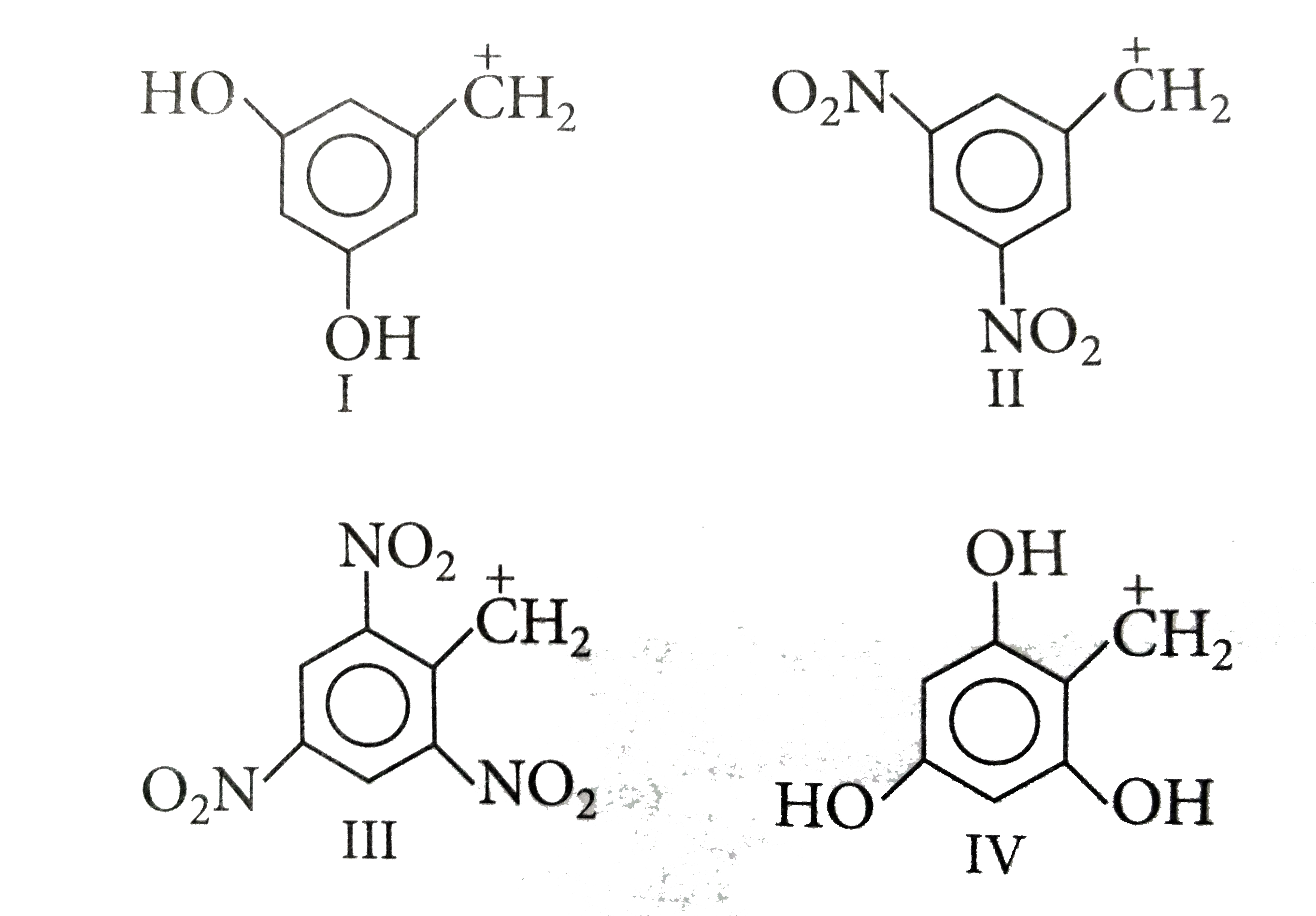Arrange the following carbocations in order of stability
benzyl allyl methyl vinyl I II III IV
IV>III>II>I
I>II>III>IV
II>IV>III>I
III>II>I>IV
The correct Answer is:B
To arrange the given carbocations (benzyl, allyl, methyl, and vinyl) in order of stability, we need to analyze each carbocation's structure and the factors that contribute to their stability.
Step 1: Identify the Structures of Each Carbocation
1. Benzyl Carbocation (I): This carbocation has a positive charge on a carbon atom that is directly attached to a benzene ring. The benzene ring can stabilize the positive charge through resonance.
2. Allyl Carbocation (II): This carbocation has a positive charge on a carbon atom that is adjacent to a double bond. The double bond can also stabilize the positive charge through resonance, but not as effectively as the benzene ring.
3. Methyl Carbocation (III): This carbocation has a positive charge on a carbon atom that is bonded to three hydrogen atoms. It does not have any resonance stabilization and is less stable compared to benzyl and allyl carbocations.
4. Vinyl Carbocation (IV): This carbocation has a positive charge on a carbon atom that is part of a double bond (sp2 hybridization). The positive charge on an sp-hybridized carbon is highly unstable due to the lack of resonance stabilization.
Step 2: Analyze Stability Based on Resonance and Hybridization
- Benzyl Carbocation: Highly stable due to resonance stabilization from the benzene ring. It can form multiple resonance structures.
- Allyl Carbocation: Moderately stable due to resonance stabilization from the adjacent double bond, but less than benzyl.
- Methyl Carbocation: Least stable as it lacks resonance stabilization.
- Vinyl Carbocation: Highly unstable due to the positive charge on an sp-hybridized carbon, which is not stabilized by resonance.
Step 3: Arrange in Order of Stability
Based on the analysis:
1. Benzyl Carbocation (I) - Most stable
2. Allyl Carbocation (II) - Moderately stable
3. Methyl Carbocation (III) - Less stable
4. Vinyl Carbocation (IV) - Least stable
Final Order of Stability
The order of stability from most stable to least stable is:
I (Benzyl) > II (Allyl) > III (Methyl) > IV (Vinyl)
1. Benzyl Carbocation (I): This carbocation has a positive charge on a carbon atom that is directly attached to a benzene ring. The benzene ring can stabilize the positive charge through resonance.
2. Allyl Carbocation (II): This carbocation has a positive charge on a carbon atom that is adjacent to a double bond. The double bond can also stabilize the positive charge through resonance, but not as effectively as the benzene ring.
- Benzyl Carbocation: Highly stable due to resonance stabilization from the benzene ring. It can form multiple resonance structures.
- Allyl Carbocation: Moderately stable due to resonance stabilization from the adjacent double bond, but less than benzyl.
- Methyl Carbocation: Least stable as it lacks resonance stabilization.
- Vinyl Carbocation: Highly unstable due to the positive charge on an sp-hybridized carbon, which is not stabilized by resonance.
Based on the analysis:
1. Benzyl Carbocation (I) - Most stable
2. Allyl Carbocation (II) - Moderately stable
3. Methyl Carbocation (III) - Less stable
4. Vinyl Carbocation (IV) - Least stable
The order of stability from most stable to least stable is:
I (Benzyl) > II (Allyl) > III (Methyl) > IV (Vinyl)
Similar Questions
Knowledge Check
Arrange the following in increasing order of stability.
 AI<II<IIIBII<I<IIICI<III<IIDII<III<I
AI<II<IIIBII<I<IIICI<III<IIDII<III<I
Arrange the followinng carbocations in decreasing order of stability

View SolutionArrange the following alkenes in order of their stability

View SolutionArrange the following carbanions in increasing order of stability:

View SolutionRank the following carbocations in order of stability (1 = most stabe)

View SolutionArrange the following carbocations in decreasing order of their stability:

View SolutionArrange the following free radicals in decreasing order of stability:

View SolutionArrange the following radicals in decreasing order of their stability.

View Solution


